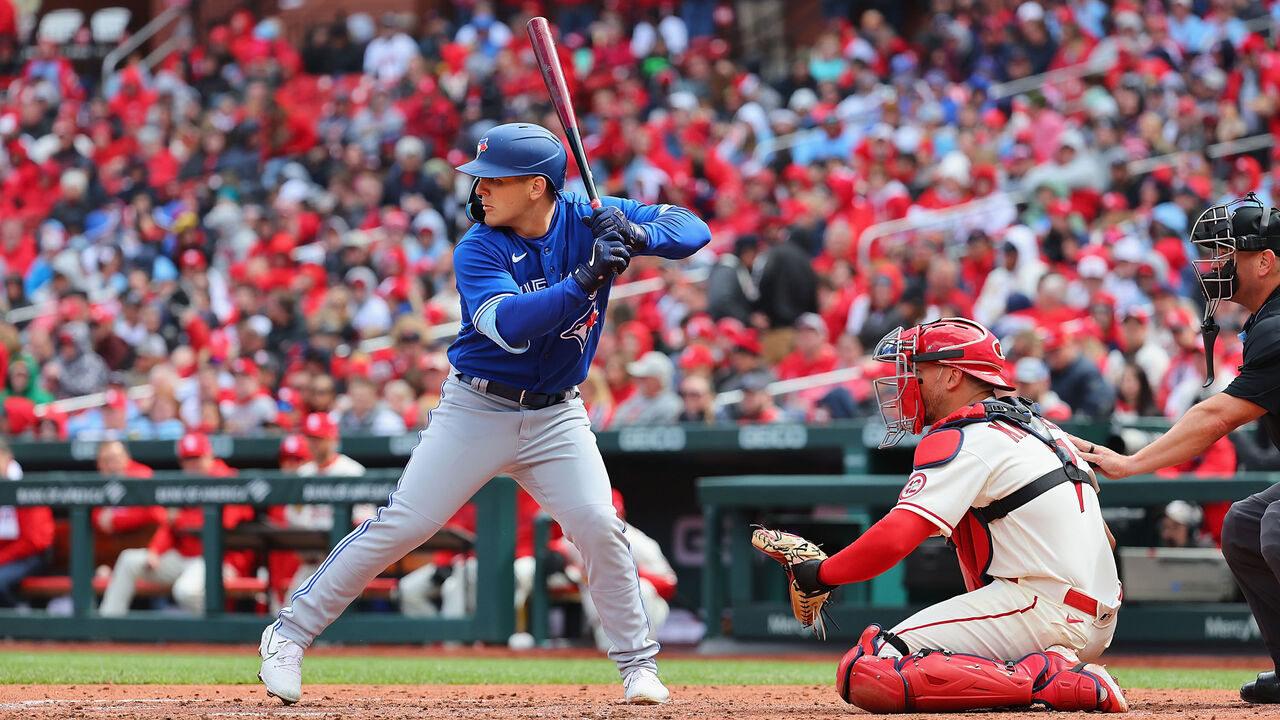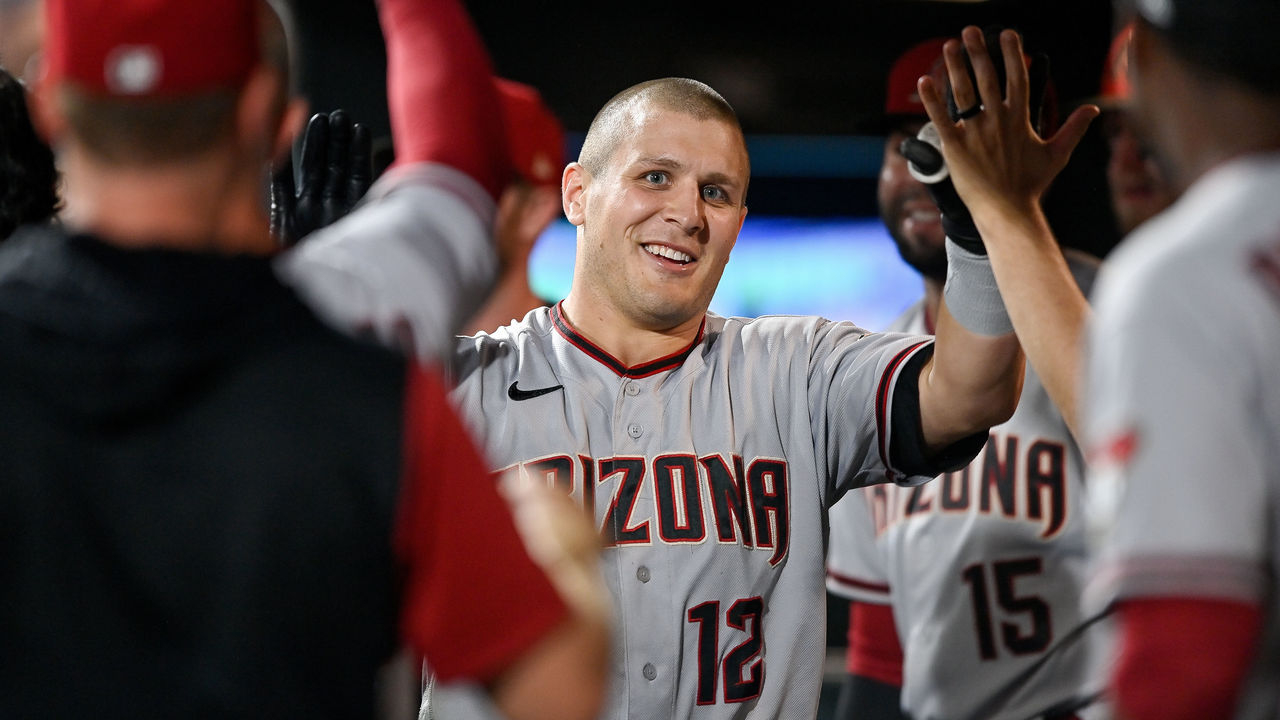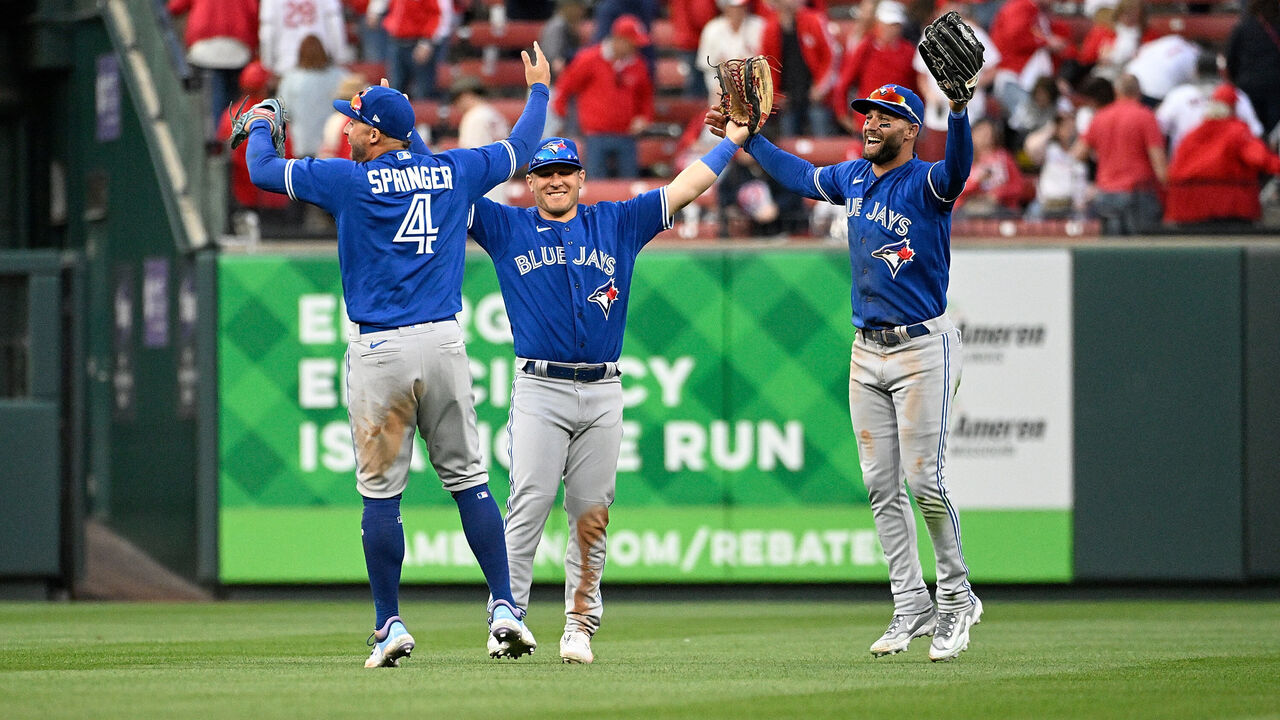Varsho's unusual talents are perfect for the Blue Jays' new blueprint
DUNEDIN, Fla. - Daulton Varsho was helping his sister prepare for a holiday party in Chili, Wisconsin, when he checked his phone on Dec. 23. He had missed a call from Arizona Diamondbacks general manager Mike Hazen.
Baseball executives do not usually call to offer holiday greetings two days before Christmas, although it wasn't Varsho's fault he was hard to reach.
"Where we live, there isn't much cell service," Varsho said.
Chili (population: 226) isn't even a one-stoplight town. Main Street lacks any traffic lights as it cuts through the farming community that's smack-dab between Green Bay and Minneapolis.
Varsho found some reception while wandering outside on a sub-zero day, a blanket of snow covering the ground. When he returned, he had some news for his sister: He'd been traded to the Toronto Blue Jays.
Initially, Varsho was shocked. He thought he'd spend the first part of his career with the Diamondbacks, who had drafted him in the second round in 2017. But the Blue Jays were a playoff team, and, as his sister noted, he'd be closer to home.
He quickly learned that no franchise was likely to value him more.
Within minutes, Ross Atkins called. The Blue Jays general manager explained why the club targeted Varsho, sending highly regarded catching prospect Gabriel Moreno and Lourdes Gurriel Jr. to Arizona in exchange.

Atkins said the Blue Jays were seeking more balance; that meant improving their defense and baserunning and becoming less right-handed-heavy in their lineup. Toronto earned a wild-card spot last season, but the roster still had flaws, and standing pat is not an option in the highly competitive American League East. Varsho checked every box the Blue Jays were looking to address.
In Major League Baseball history, only five players played at least 80 games at catcher and 80 games in the outfield through their first three seasons, and just two have done it since 1909: Hall of Famer Gary Carter and Varsho.
Refine the search to at least 80 games at catcher and center field in the first three years of a career, and just Varsho remains. Going back to 1901, three players have reached 80 games played in center and at catcher over their entire careers: Varsho, Craig Biggio, and Dale Murphy.
Catchers don't usually transition to the outfield, let alone center field, and they don't usually play elite defense once they get there. But that's exactly what Varsho did in Arizona last year en route to a 4.7 WAR season. He tied Michael A. Taylor for first in defensive runs saved (19) in the outfield.
Varsho hardly played outfield prior to arriving in the major leagues. He wanted to catch, and that's what he did almost exclusively for Marshfield High School and the University of Wisconsin-Milwaukee, one of the few Division I schools interested in him.
"Trying to find a college that wanted me as a catcher was pretty tough," Varsho said. "They all said I was too short and couldn't throw well enough."

In the minor leagues, he logged 1,570 innings at catcher and only 90 in the outfield. So how do you become an elite outfielder after spending nearly your entire amateur career, and most of your minor-league time, at catcher?
Part of it relates to the benefits of being a big leaguer's son. The Blue Jays now roster four of them: Bo Bichette, Cavan Biggio, Vladimir Guerrero Jr., and Varsho.
After his playing career as an outfielder, Gary Varsho remained in baseball. He was the bench coach for the Philadelphia Phillies from 2002-06 when Daulton was aged 6-10. Daulton was with him often.
When school was out in the summer, the family would often visit Philadelphia. And when school was in session, Daulton and his sisters and mother would visit their dad when the Phillies made Midwest stops closer to Wisconsin.
Named after former major-league catcher Darren Daulton, who also played some outfield, Varsho rattles off the parks where he shagged fly balls as a kid: Citizens Bank Park in Philadelphia, American Family Field in Milwaukee, Wrigley Field and Guaranteed Rate Park in Chicago, and PNC Park in Pittsburgh.
"I was always out in the outfield with my dad," Varsho said. "All the (Phillies) pitchers are just watching me run back and forth. They got a little kid here to waste his energy so we don't waste ours. It was a great experience as a little kid."
He tracked countless fly balls off the bats of major-league hitters as a child and believes that's how he developed his instincts. He characterizes his tracking skills as more learned than innate.
"I would say it's more reps," Varsho said. "Being able to take live reads during BP, understanding swings. That's the biggest thing. One of the things I've learned is when you are able to take like one round of BP and really get after it, you don't have to run after every ball, but being able to take that first step and go in the right direction, it's a big advantage. I work on it."
He also believes that playing multiple sports - especially football, where he was an all-state selection at free safety - increased his athleticism.
Varsho only transitioned to the outfield because of Carson Kelly's presence at catcher in Arizona. Following the 2021 season, he worked with his trainer on opening his hips more quickly from starting position, he told Fan Nation's Jack Sommers. Diamondbacks coach Dave McKay gave him valuable advice on how to position his feet in right field versus in center. His father stressed the importance of accurate first steps.
And he excelled immediately.
While his sprint speed ranked above average (69th percentile) last year, his first step and his instincts were exceptional despite his lack of professional experience. He ranked in the 97th percentile in outfield jumps, a Statcast metric that combines first-step quickness, speed, and route efficiency.
Varsho averaged 37.4 feet of coverage during a batted ball's first three seconds of flight, which ranked fifth in the majors. By comparison, Gurriel Jr., the Jays' primary left fielder last season, averaged 31.7 feet. Varsho's jump was a combined 3.7 feet above average, which ranked fourth behind Kyle Isbel, Brett Phillips, and Enrique Hernandez.
The outfield jump metric is broken down into three subcategories:
Varsho was above average in all three.
He ranked in the 99th percentile of Statcast's Outs Above Average category during his 920 innings in the outfield last season. That was more than double the innings he played in the outfield during his previous eight seasons in college and pro ball.
"Being able to understand how good I was, it was just an eye-opening experience for me," Varsho said. "'OK, I can do this.' ... It was kind of a twist for me."
A skeptic would say a larger sample of work was needed to verify that Varsho is an elite performer. But Atkins said the Blue Jays were believers.
"It just aligned with all of our scouts' looks, their views, our reports," Atkins said of the advanced stats. "It aligned with our internal staff assessment of him as well. We felt the sample size was strong enough for it to be considered more than real."
There's a much bigger sample on Kevin Kiermaier, whom Toronto signed to play center a week before trading for Varsho. Varsho will mostly play in left field. Kiermaier consistently ranks in the 90th percentile or better in outs above average, jump, throwing arm, and sprint speed. Even as he dealt with a hip injury that required surgery last year, he was still in the 90th percentile for the latter.
"We have three weapons out there that are going to work together and make our pitchers feel very comfortable," Kiermaier said of being flanked by Varsho and George Springer.
The Houston Astros and Tampa Bay Rays rank first and second in outfielder defensive runs saved since 2015. They've also been consistent playoff teams. The Blue Jays ranked 21st in the majors in defensive runs saved in the outfield last season.
"All of a sudden, our outfield defense is very different," Atkins said.

The upgrades are especially welcome news for Blue Jays pitchers. Last season, Toronto's staff was 25th in ground-ball rate (41.4%) and had the 11th-highest batting average on balls in play (.295). Kevin Gausman allowed the highest BABIP (.363) among qualified pitchers.
"Bringing in those guys is huge," Gausman said of Varsho and Kiermaier. "Taking one of the best center fielders in the game (Varsho) and moving him to a corner is like, 'Wow.' Varsho is an unbelievable outfielder.
"One thing we didn't really do that well last year is not beat ourselves. We had a lot of games where we ended up losing by one run. We look back at small things, like we didn't hit the cutoff man. If we hit the cutoff and throw to third, the guy is out by 30 feet. That's one thing we've been preaching since the start of spring: Do those small things really well. Every year, the Dodgers win a lot of games because their defense is really good. Their starting staff is great, but they don't beat themselves very often."
The Dodgers are outliers, owners of the lowest BABIP allowed in the majors from 2020-22 (.257). The Blue Jays rank 19th (.292).
Varsho believes his ball-tracking foundation was built at an early age, but he identifies one innate gift in addition to his foot speed: eyesight. In the outfield, he believes it helps his initial read of a swing, as well as a ball's exit trajectory and speed. And at the plate, Varsho says he can see the spin of the baseball. The Blue Jays needed Varsho's glove, but they also needed his bat.
After his initial call with Atkins, Varsho drove 10 minutes across Chili to his parents' 80-acre, wooded property where he was raised. His father had already experienced being traded while trying to establish himself in the majors, moving from the Cubs to the Pirates in 1991.
"They thought I was kidding when I told them," Varsho said. "He was thrilled."
The family wouldn't have to travel as much to watch him play and wouldn't have to stay awake past midnight as often to watch his games.

Beyond being able to shag baseball in stadiums, Varsho benefited from having a major-league dad in other ways.
Gary built an indoor batting cage on the property in 1996, the year Daulton was born. "When I was younger, having that in a cold-weather climate was a huge advantage," Daulton said.
The Blue Jays totaled 4,085 plate appearances from right-handed hitters facing right-handed pitchers last season. That was nearly 600 more than the second-ranked Miami Marlins and approached double the MLB midpoint.
Varsho should be a great match for the new-look Rogers Centre, where the right-center wall was brought in by 16 feet and only raised by 4 feet. That's expected to equal more home runs.
Varsho smashed 27 home runs last year. And he did it with only modest exit velocity: 66th percentile in maximum exit velocity, 25th percentile for his average. (He might be improving in this area: His first hit this year, a double in the opener at St. Louis, registered a career-best exit velocity of 112 mph.)
#BlueJays Daulton Varsho set his MLB Career-high max exit velocity of 112.5 mph on this double on Opening Day
— Mike Kurland (@Mike_Kurland) March 31, 2023
Previous career-high: 110.9 mph in 2021pic.twitter.com/rRrrMC5jp5
Varsho has created power by lifting the ball to his pull side in a way few major-league batters can: 34.5% of the balls he put in play last season were in the air to his pull side. That ranked 25th among the 375 hitters last year who had at least 50 batted balls.
Adding Varsho, Kiermaier, and Brandon Belt gives Toronto the left-handed balance it lacked last year.
When he gets on base, Varsho is also an adept runner - a timely addition as stolen-base success rates have reached record levels early this season after MLB's rule changes.
By FanGraphs' baserunning metric, Varsho was the 26th-best baserunner in the game last year. He's stolen 26 bases in 33 career attempts. Varsho also takes the extra base 51% of the time, well above league average (41%).
The Blue Jays were middle of the pack last year in adding value on the bases and league average at taking an extra bag, advancing two bases on a hit just 41% of the time.
Pratto was gathering up the ball at this moment and Varsho still scored as the throw was hopper into the cutoff man. Yikes pic.twitter.com/CBkMohwk6X
— Jason Collette (@jasoncollette) April 6, 2023
"A lot of emphasis on baserunning and defense for us," Atkins said of Toronto's revamped approach. "We feel like we are in a really strong position in a number of areas, where on any given night we are going to have (several) ways to beat teams."
Varsho might not be the face of the Blue Jays, but he might be the perfect example of their new philosophy.
Travis Sawchik is theScore's senior baseball writer.
HEADLINES
- Padres make history with 21-0 shutout of Rockies
- Astros' McCullers, family got death threats after tough start
- Burnes throws 7 dominant innings as D-Backs shut out Dodgers
- Base stealers are running wild, but catchers have one thing going for them
- Twins' Baldelli hurls hat onto field after giving umpire an earful